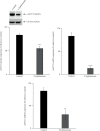Salmonella Typhimurium Infection Reduces the Ascorbic Acid Uptake in the Intestine
- PMID: 36704315
- PMCID: PMC9873446
- DOI: 10.1155/2023/2629262
Salmonella Typhimurium Infection Reduces the Ascorbic Acid Uptake in the Intestine
Abstract
Salmonella Typhimurium infection of the gastrointestinal tract leads to damage that compromises the integrity of the intestinal epithelium and results in enterocolitis and inflammation. Salmonella infection promotes the expression of inflammasome NLRP3, leading to activation and release of proinflammatory cytokines such as IL-1β, and the infected host often displays altered nutrient levels. To date, the effect of Salmonella infection and proinflammatory cytokine IL-1β on the intestinal uptake of ascorbic acid (AA) is unknown. Our results revealed a marked decrease in the rate of AA uptake in mouse jejunum infected with Salmonella wild type (WT). However, the nonpathogenic mutant (Δ invA Δ spiB) strain did not affect AA uptake. The decrease in AA uptake due to Salmonella WT infection is accompanied by significantly lower expression of mouse (m)SVCT1 protein, mRNA, and hnRNA levels. NLRP3 and IL-1β expression levels were markedly increased in Salmonella-infected mouse jejunum. IL-1β-exposed Caco-2 cells displayed marked inhibition in AA uptake and significantly decreased hSVCT1 expression at both protein and mRNA levels. Furthermore, the activity of the SLC23A1 promoter was significantly inhibited by IL-1β exposure. In addition, GRHPR (a known SVCT1 interactor) protein and mRNA expression levels were significantly reduced in Salmonella-infected mouse jejunum. These results indicate that Salmonella infection inhibits AA absorption in mouse jejunum and IL-1β-exposed Caco-2 cells. The observed inhibitory effect may partially be mediated through transcriptional mechanisms.
Copyright © 2023 Trevor Teafatiller et al.
Conflict of interest statement
No potential conflict of interest was reported by the authors.
Figures





Similar articles
-
Enteropathogenic Escherichia coli Infection Inhibits Intestinal Ascorbic Acid Uptake via Dysregulation of Its Transporter Expression.Dig Dis Sci. 2021 Jul;66(7):2250-2260. doi: 10.1007/s10620-020-06389-x. Epub 2020 Jun 17. Dig Dis Sci. 2021. PMID: 32556816 Free PMC article.
-
Enterotoxigenic Escherichia coli heat labile enterotoxin inhibits intestinal ascorbic acid uptake via a cAMP-dependent NF-κB-mediated pathway.Am J Physiol Gastrointest Liver Physiol. 2019 Jan 1;316(1):G55-G63. doi: 10.1152/ajpgi.00259.2018. Epub 2018 Oct 4. Am J Physiol Gastrointest Liver Physiol. 2019. PMID: 30285481 Free PMC article.
-
Salmonella infection inhibits intestinal biotin transport: cellular and molecular mechanisms.Am J Physiol Gastrointest Liver Physiol. 2015 Jul 15;309(2):G123-31. doi: 10.1152/ajpgi.00112.2015. Epub 2015 May 21. Am J Physiol Gastrointest Liver Physiol. 2015. PMID: 25999427 Free PMC article.
-
Limited role for ASC and NLRP3 during in vivo Salmonella Typhimurium infection.BMC Immunol. 2014 Aug 13;15:30. doi: 10.1186/s12865-014-0030-7. BMC Immunol. 2014. PMID: 25115174 Free PMC article.
-
Inhibition of intestinal ascorbic acid uptake by lipopolysaccharide is mediated via transcriptional mechanisms.Biochim Biophys Acta Biomembr. 2018 Feb;1860(2):556-565. doi: 10.1016/j.bbamem.2017.10.010. Epub 2017 Oct 10. Biochim Biophys Acta Biomembr. 2018. PMID: 29030247 Free PMC article.
Cited by
-
Temporal changes in fecal swine microbiome primarily reflect Salmonella Typhimurium challenge and poor sanitary housing conditions, even with functional amino acid supplementation.Front Vet Sci. 2025 Jul 23;12:1597857. doi: 10.3389/fvets.2025.1597857. eCollection 2025. Front Vet Sci. 2025. PMID: 40771956 Free PMC article.
-
Short-term alterations in dietary amino acids override host genetic susceptibility and reveal mechanisms of Salmonella Typhimurium small intestine colonization.bioRxiv [Preprint]. 2025 Mar 25:2025.03.25.645332. doi: 10.1101/2025.03.25.645332. bioRxiv. 2025. PMID: 40196486 Free PMC article. Preprint.
-
Destruction of the brush border by Salmonella enterica sv. Typhimurium subverts resorption by polarized epithelial cells.Front Microbiol. 2024 Jun 4;15:1329798. doi: 10.3389/fmicb.2024.1329798. eCollection 2024. Front Microbiol. 2024. PMID: 38894970 Free PMC article.
-
Fisetin alleviates Salmonella typhimurium-induced colitis through the TLR2/TLR4-NF-κB pathway, regulating microbiota, and repressing intracellular bacterial proliferation by focal adhesion kinase.Eur J Nutr. 2025 Mar 19;64(3):128. doi: 10.1007/s00394-025-03602-3. Eur J Nutr. 2025. PMID: 40106033
-
Microencapsulated Limosilactobacillus reuteri Encoding Lactoferricin-Lactoferrampin Targeted Intestine against Salmonella typhimurium Infection.Nutrients. 2023 Dec 18;15(24):5141. doi: 10.3390/nu15245141. Nutrients. 2023. PMID: 38140400 Free PMC article.
References
-
- Packer L., Fuchs J. Vitamin C in Health and Disease . New York, NY, USA: Marcel Dekker Inc; 1997.

